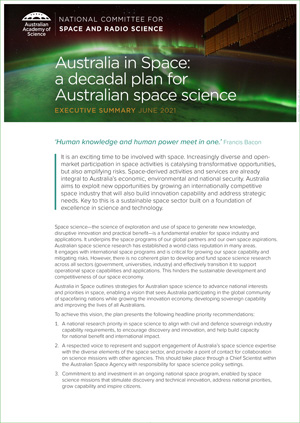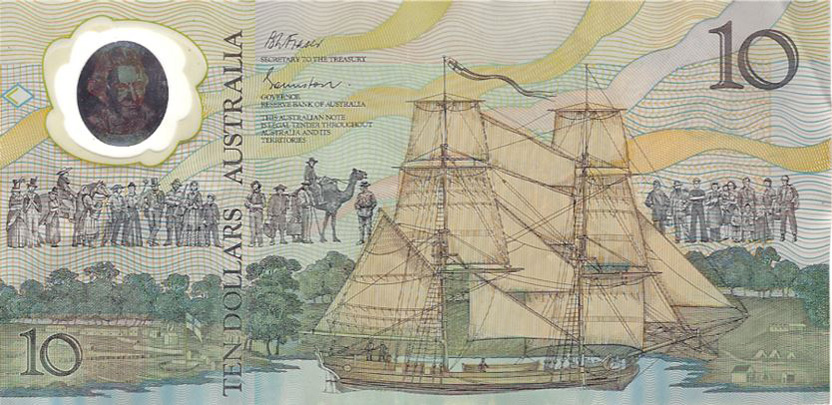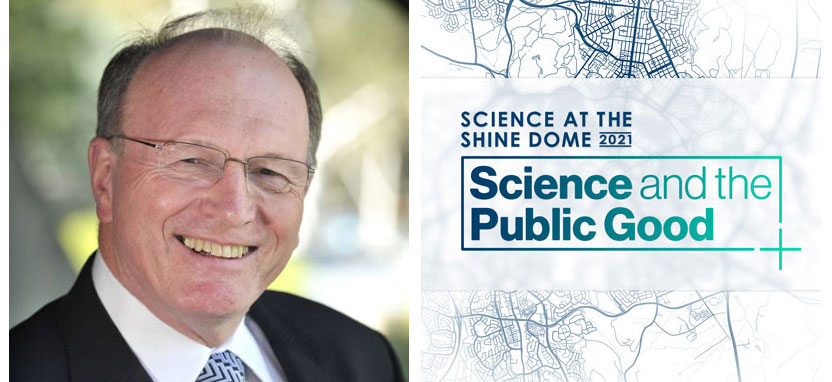
Contribute to the Space and Radio Science newsletter
If you would like to list your event or opportunity, or otherwise contribute to the next edition of the Space and Radio Science newsletter, please send content to icsu@science.org.au. Contributions will be published subject to approval by the National Committee for Space and Radio Science.
Subscribe
The National Committee provides this regular emailed newsletter containing updates from international scientific unions and committees and news related to the local scientific community, relevant funding opportunities, conferences and awards.

The National Committee for Space and Radio Science (NCSRS) is seeking to engage more with the Australian radio science community. The main remit of NCSRS is to act as a conduit between the Australian research community and the International Union of Radio Science (URSI). The Committee is seeking input on how it can better connect with and consult the Australian radio science community on key URSI issues to ensure effective Australian representation at URSI.
Send through your thoughts for improving connections to the Australian Radio Science community by completing this form.
Your feedback is also invited on an exposure draft executive summary of the next decadal plan for Australian space science.
Ross McPhedran
Member, National Committee for Space and Radio Science, Australian Academy of Science
The subject of radio science has a history which occupies essentially the same period as that of the Commonwealth of Australia (1901 onwards). The two have been interlinked strongly over that period, with radio contributing to better communications and then to the defence of Australia during the First World War. Gradually, Australian science and technology have developed in areas relevant to radio science, and our scientists and technologists have made important contributions to the field.
I have written an account of the history of radio science. It uses the definition of radio science adopted by the Union Radio-Scientifique Internationale (URSI), the international organisation which has championed the field since the 1920s. The article aims to showcase the development of the field, and in particular major advances made by Australian science and technology. It highlights the combination of achievements in research of both a pure and an applied nature and their effects in improving quality of life in Australia. This is a field that is always important to Australia and which continues to provide challenging and rewarding opportunities to its scientists and engineers.
The figure below shows one side of the short-lived Bicentennial $10 note, issued in 1988 to commemorate the founding of the settlement in Sydney Cove by the First Fleet. This was the first Australian polymer bank note, and featured in the image of Captain Cook at top left an optically-variable security device based on curvilinear diffraction grating technology developed in the CSIRO Division of Chemical Physics. The same technology greatly refined has been used in subsequent Australian bank notes.

Recipients of the Moon to Mars Demonstrator Feasibility Grants have been announced. Successful projects demonstrate clear potential to support future Moon to Mars activities, including in the areas of advanced communications, remote sensing, autonomous systems and propulsion systems. There are some particularly exciting projects, such as Curtin University’s Binar program to develop the capability for CubeSat missions to the Moon, and separate projects at a number of universities to develop in orbit and ground-based optical communications capability. The latter are examples of potentially breakthrough R&D straddling space and radio science domains.
The Australian Government continues to focus on developing the Australian space industry. On 10 February 2021, the Academy made a submission to the Standing Committee on Industry, Innovation, Science and Resources inquiry into Developing Australia’s Space Industry. The inquiry is ongoing, with resources published online. Many submissions and transcripts of the public hearings are especially interesting. If you only have 10 minutes of time, the transcript of Dr Paul Scully-Power’s remarks on 19 April is recommended.
CUAVA, the Australian Research Centre (ARC) Training Centre for CubeSats, Uncrewed Aerial Vehicles and their Applications, has been selected to head up ‘Waratah Seed’. Funded by the NSW Government, Waratah Seed is a pilot space qualification project to launch NSW-developed space technology into orbit to test and prove functionality. The project is focused on developing the Australian space industry.
Technologies enabled by space often have uses in defence operations, and the dual-use applications of space technology makes space the next defence domain.
Australia has recognised the potential for space to be a war-fighting domain in the establishment of an Australian Space Division within the Royal Australian Air Force. A Cosmos article discusses the question: Will there be wars in space? and addresses the establishment of Australia’s space division and appointment of space as an operational warfighting environment in the 2020 Defence Strategic Update.
A recent meeting of member countries to NATO in Brussels extended their collective defence clause to include acts of war in space, meaning that if a member country is attacked as an act of war in space that it could trigger a response from all the other members as part of the treaty.
The Australian National University’s National Security College has released a Policy Options Paper, Australia as a Space Power: Combining Civil, Defence and Diplomatic Efforts. The paper discusses space as a critical strategic domain for Australia’s civilian and military interests that is becoming increasingly congested, contested and competitive. The paper explores how Australia should approach the space domain in the years ahead, in pursuit of national interest objectives.
Space junk has the potential to limit satellite operations and other technologies. Recently the International Space Station was damaged when space junk hit the robotic arm, and the world watched as an uncontrolled Chinese rocket fell to earth. With more debris in orbit than operational satellites, space junk is an evident issue in space science. The European Space Agency released its Space Environment Report 2021 in May, finding that current activities in space are unsustainable and if we continue as we are, the number of objects in orbit, both operational and debris, will seriously inhibit sustainable use of space.
Space junk may be impacted by climate change, as discussed in a recent New York Time article, What if space junk and climate change become the same problem? Increasing carbon dioxide levels may decrease upper atmosphere density and reduce the effects of orbital drag. This would result in less orbital decay and burnup of space objects, adding more space junk.
There is currently no consensus on solutions for removal of space junk, and it has become a space age ‘tragedy of the commons’. Space junk removal is not going smoothly, due to the number of different objects littering orbit and the need for different approaches to take out the orbital trash.
To mitigate the risk of collision with space junk, objects in orbit are often manoeuvred to avoid collision. Electro Optic Systems unveiled a new laser technology that will help reduce the risk of collision when it is not possible to manoeuvre away from the path of space junk, instead using a laser to mover the space debris away from the path of another object.
One outcome of the G7 Leaders’ Summit in June 2021 is a joint agreement on sustainable use of space. Section 35 of the communique states “We are committed to the safe and sustainable use of space to support humanity’s ambition now and in the future. We recognise the importance of developing common standards, best practices and guidelines related to sustainable space operations alongside the need for a collaborative approach for space traffic management and coordination. We call on all nations to work together, through groups like the United Nations Committee on the Peaceful Uses of Outer Space, the International Organization for Standardization and the Inter-Agency Space Debris Coordination Committee, to preserve the space environment for future generations.”
Section 36 of the same document discusses the importance of scientific discovery and its deployment, and stronger collaboration on research and development.
Deloitte Access Economics was engaged by Geoscience Australia to support the development of the Australian Space Agency’s Earth Observations from Space Technology Roadmap through a detailed economic study of Australia’s Earth observation sector. Its report on the Economics of Earth Observation finds that Australia is highly dependent on Earth observation data from external providers. As a “free rider” of data provided under open access arrangements, the risk of a denial of service is significant, and the economic consequences of such an event grow with Australia’s increasing reliance on Earth observation data.
A new Australian space start-up, Quasar Satellite Technologies, has launched with support from CSIRO, to tackle the challenge of the incoming influx of satellite data by tracking hundreds of satellites simultaneously, bolstering current communications capabilities between ground stations and deployed satellites. The leap in satellite communications capacity is based on Australian technologies used by CSIRO to collect data from the ASKAP Radio telescope in WA.
A new report from AgriFutures Australia, Space-based technologies – opportunities for the rural sector, discusses agriculture as the next frontier for space technology, with billion-dollar opportunities to super-charge technology adaptation for farmers, fishers and foresters over the next five years. The report investigates how space will support the farmer of the future and how space technologies could be applied to solve agricultural challenges.
Spark Operational, developed by CSIRO and the National Council for Fire and Emergency Services (AFAC), is a simulator that produces predictions, statistics and visualisations of bushfire spread. The new version of Spark will be used nation-wide to model and predict bushfires and help to respond to increasingly severe and often unpredictable bushfires.
The Western Australia (WA) based low-frequency radio telescope Murchison Widefield Array (MWA) has discovered a pulsar, a dense and rapidly spinning neutron star sending radio waves into the cosmos, the International Centre for Radio Astronomy Research (ICRAR) has confirmed. MWA is a forerunner to the upcoming Square Kilometre Array (SKA), which recently secured a $387 million support package from the Australian Government. SKA is a global collaboration between 16 countries and will construct the largest science facilities in the world. WA has received $64.4 million in funding to process the astronomical amount of data of the SKA. Such radio astronomy capability is built on the back of research in radio and space science.
As Australia looks to develop its space industry, competition with New Zealand’s space industry is possible. New Zealand’s demonstrated launch capabilities put Australia’s space industry on the back foot, but also open the potential for Australia to coordinate space launch capabilities with New Zealand, writes a recent Australia Strategic Policy Institute article.
New Zealand has signed NASA’s Artemis Accords, several months after the United States and Australia. The Artemis Accords establish principles to guide space exploration cooperation. New Zealand became the 11th signatory, though it continues to urge that countries must make agreements on the conduct of space mining to ensure that the principles of the Accords are met.
The SmartSat Cooperative Research Centre (CRC) is an Australian consortium of universities and other research organisations partnered with industry, that has been funded by the Australian Government to develop know-how and technologies in advanced telecommunications and IoT connectivity, intelligent satellite systems and Earth observation analytics.
The SmartSat invites expressions of interest for higher degrees by research (PhD) scholarships commencing in 2021. Successful candidates will need to be enrolled with one of its university partners and will work on applied R&D which align with its research programs.
The SmartSat CRC website has details of priority topic areas, eligibility, benefits, application process and deadlines.
The Andy Thomas Space Foundation Education Fund provides financial assistance for deserving projects to young Australians. The Foundation is committed to driving progress at a national level in education, research and innovation. The Foundation is offering scholarships, awards and prizes to a value of $150,000 under five programs, with applications for three still open.
COSPAR is now calling for nominations for the COSPAR Awards. As the National Adhering Organisation, nominations from Australia can be made via the Australian Academy of Science, subject to approval from the Academy’s Executive Committee. Anyone wishing to be nominated for a COSPAR award via the Academy should send a nomination package to icsu@science.org.au by 30 September 2021.
The Academy is hosting a wide range of events during the second half of 2021, including the following two in the Science at the Shine Dome series. Find out more about the Academy’s events.
Professor Andrew Holmes AC FAA FTSE FRS, University of Melbourne
Date: Wednesday 28 July 2021
Time: 7.00 pm – 7.45 pm AEST
Venue: Online
The Matthew Flinders Medal and Lecture is a career award that recognises scientific research of the highest standing in the physical sciences, and honours the contributions of Australia's early scientific researchers.
Date: Thursday 12 August 2021
Time: 1.00 pm – 3.10 pm AEST
Venue: Shine Dome and online
The Academy will explore the value of science to everyone, with speakers exploring the critical importance of studying mathematics, chemistry, biology and physics, and how this fundamental knowledge is essential to scientific advances.

© 2025 Australian Academy of Science